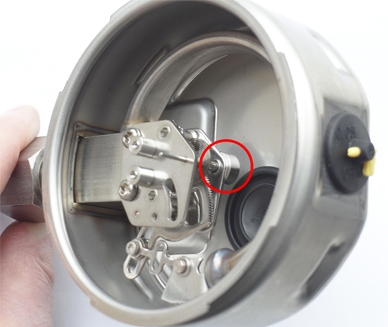
Vibrations can sometimes violently load Bourdon tube pressure gauges. They cause pointer flutter and also, in the event of sustained loading, damage to the measuring system, even to the point of total failure. The most effective protection against these effects is provided by measuring instruments with case filling.
The principle is simple: The pressure gauge case is filled with a liquid, usually glycerine or silicone oil. In the case of vibrations, the case filling optimally dampens the vibrations of the Bourdon tube, transmission mechanism and movement. It therefore prevents pointer flutter, and thus the displayed measured value remains clearly readable. At the same time, the measuring system is protected against premature wear, since the fill fluid acts as a lubricant for the moving components. This considerably extends the service life of the pressure gauge.

Figure 1: View of the inside of a pressure gauge with a dampened movement. The circle marks the seat of the pot with the silicone oil that accommodates the pointer pinion.
Highly viscous silicone oil
As an alternative to an instrument with case filling, a pressure gauge with silicone-dampened movement is often chosen. In this design, the pointer pinion moves in a pot of highly viscous silicone oil. As a result, the pointer also operates largely free of vibration. However, this effect, which is necessary for immobilising the pointer, slows down other moving components of the movement. The result is a significantly higher wear of these parts than with a pressure gauge with fill fluid.
WIKA confirmed this information some time ago in an internal laboratory test with different pressure gauge versions. Unfilled pressure gauges, pressure gauges with dampened movement and pressure gauges with case filling were subjected to an endurance test under practical conditions which were harsher than those of the EN 837-1 pressure gauge standard. The investigation produced the following results:
| Pressure gauge version (type of dampening) | Zero point offset after 50 hrs / 200 hrs | Condition of the instruments after 200 hours |
| Unfilled / without dampening | 2,3% / 3.0% | Conditionally functional |
| Dampened movement | 2,3% / 66% | No longer functional |
| Liquid-filled | 0,6% / 0,8% | Fully functional |
Fast wear
In the test, the unfilled variant turned out to be relatively resistant. However, given the inevitable pointer flutter, such a pressure gauge is not recommended for applications with vibrations. This verdict also applies to the version with dampened movement, particularly in applications with stronger and sustained vibrations. The pointer stability is, in this case, countered by a rapid wear of the other moving parts. This version was, already, no longer functional well before the end of the test.

Figure 2: Cracks in the Bourdon tube or a worn-out link are examples of typical vibration damage in the mechanisms of pressure gauges. Such wear is prevented by case filling.
The pressure gauge with case filling was the only variant which remained fully operational. Because of the fill fluid, the risk of leakage is often used as an argument against this type of instrument. WIKA cases with filling are therefore designed and handled to reduce the risk of leakage as a result of vibration to a minimum.
Note
For more information on our range of pressure gauges, visit the WIKA website.
See also our article
Filling liquids in pressure gauges: Usage and advantages

